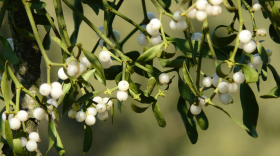The Florida Fish and Wildlife Conservation Commission is enlisting the help of licensed recreational anglers. It’s a new way to monitor the health of marine life in the Gulf of Mexico. The Gulf Reef Fish Survey involves conducting dockside interviews and mailing surveys to the fisherman. It stretches from Naples to the Alabama state line.
FWC fisheries biologist Scott Faulkner is sent out to different marinas every weekend. On a Saturday in August, he walked the docks of the Cocohatchee Marina in North Naples.
"We're walking to a boat that is parked right over here and we're going to try and interview them," said Falkner.
He and his partner for the day, FWC biologist Colleen Chabot, approached Gulf fisherman Steve Ritter who had just hauled his boat from the water with his pickup.
"Hey sir, how you doing? I'm with FWC and we're doing Gulf reef fish surveys today," Falkner said to Ritter. "Do you mind if I ask you a few questions?"
Once Ritter gave him the "go ahead," Falkner asked Ritter what kind of fish he caught, how many he threw back, and how many he kept. Ritter said he kept one Red Grouper. It’s one of the nine species FWC is looking out for, and the most commonly caught on that list.

The interview is part of the Gulf Reef Fish Survey. FWC started this study around April to better track fish populations.
Beverly Sauls of FWC leads this project from Saint Petersburg. She said catch from Florida’s more than one million licensed anglers is hardest to track.
"These are strictly people out fishing with their families for fun on the weekends on small boats in small groups from thousands of potential access points," said Sauls. "It's just a little more challenging to just get a good handle on how many fish are being caught by that many people."
She said it’s not just about dockside interviews—FWC also mails surveys to licensed anglers who live along the Gulf.
"Our return rate through the mail survey is right about 25 percent, which is a decent return rate. But we'd like to see that higher up around 30 or 40 percent in order to have good confidence in the estimates that we're generating," said Sauls.
So it’s a two-fold approach: surveys get mailed to anglers’ homes, and the dockside interviews conducted at 195 places along the gulf coast.
Back at the Cocohatchee Marina, biologist Colleen Chabot was still talking to recreational angler Steve Ritter. She ended the interview with what she called a “weird question” about his Red Grouper catch.
"After you filet it, can I keep the carcass?" Chabot asked Ritter. Ritter immediately agreed.
"He's gonna filet the fish and then afterwards we're gonna take its otoliths out, which are technically like their ear bones," said Chabot.
Otoliths are calcium buildups that when looked at under a microscope, tell the fish’s age, kind of like counting rings on a tree trunk.

Steve Ritter sliced the meat off of the five-pound Red Grouper with an electric knife. He handed the leftovers to biologist Colleen Chabot, so she could extract the grouper’s ear bones from its head.
The otoliths are inside the brain cavity. And there are two different ways to get in there: cut through its head or through its gill. Chabot used a long knife to cut into the gill.
After about two minutes, she found what she was looking for.
"I think I found it-- that's the otolith right there," said Chabot, peering into the grouper's pink and white brain cavity.
It looks like a small white fish scale, but thicker. Chabot put it in a plastic vile to send it to other FWC biologists, like Jessica Carroll, for analysis .
"So an otolith comes to our lab, we find out the age, and we send the age to people who run data analysis and run stock assessments," said Carroll.
She said the average age of the Red Grouper recreational anglers are catching in the Gulf right now is six- years-old. Carroll said knowing the age of the different species helps FWC set restrictions to prevent over-fishing.
"So what it tells you is that you have a very young population and those species tend to reproduce and mature slowly," she said. "So what we wanna do when we set regulations is we want to protect those fish when they're younger so that they can grow up to be older."

Carroll says the Gulf’s Red Grouper population is healthy and it’s not currently being overfished. The Florida Fish and Wildlife Conservation Commission plans to collect recreational fishing data from the Gulf for the next five years. FWC hopes, by then, to have a more accurate count of the Gulf’s fish population.








